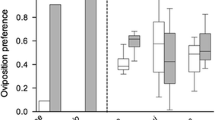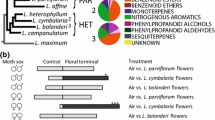Abstract
We analyzed geographic differentiation in oviposition preference in the anise swallowtail butterfly, Papilio zelicaon Lucas, which is one of the most widely distributed and polyphagous butterflies in western North America. Among 13 populations that span 1200 km of the range of P. zelicaon in the Pacific Northwest of North America, the overall oviposition preference hierarchy has not diverged significantly, even though these populations differ in the plant species they use in the field. The results indicate that differences in host availability and use have not favored major reorganizations in the preference hierarchy of ovipositing females. Instead, this butterfly has a conserved preference hierarchy that varies within a narrow range among populations. All populations ranked the four test plant species in the same overall relative order, even though these populations differ in the plant species they use in the field.
Similar content being viewed by others
Author information
Authors and Affiliations
Additional information
Received: 9 February 1996 / Accepted: 24 February 1997
Rights and permissions
About this article
Cite this article
Wehling, W., Thompson, J. Evolutionary conservatism of oviposition preference in a widespread polyphagous insect herbivore, Papilio zelicaon . Oecologia 111, 209–215 (1997). https://doi.org/10.1007/s004420050227
Issue Date:
DOI: https://doi.org/10.1007/s004420050227




